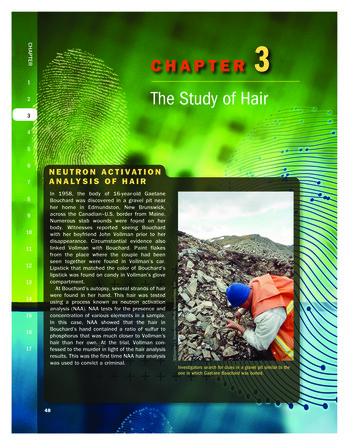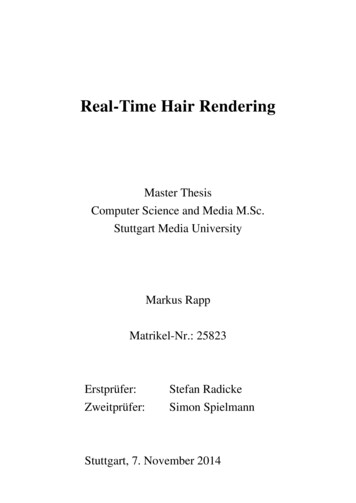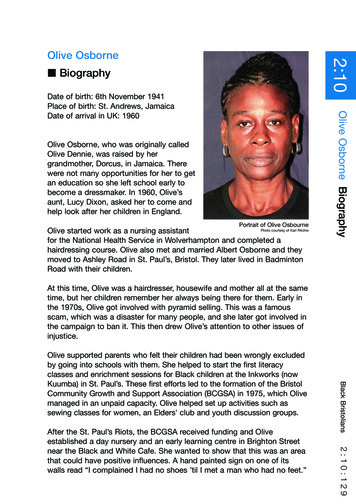
Transcription
CHAPTERCHAPTER13The Study of Hair23457891011121314151617N E U T R O N A C T I VAT I O NA N A LY S I S O F H A I RIn 1958, the body of 16-year-old GaetaneBouchard was discovered in a gravel pit nearher home in Edmundston, New Brunswick,across the Canadian–U.S. border from Maine.Numerous stab wounds were found on herbody. Witnesses reported seeing Bouchardwith her boyfriend John Vollman prior to herdisappearance. Circumstantial evidence alsolinked Vollman with Bouchard. Paint flakesfrom the place where the couple had beenseen together were found in Vollman’s car.Lipstick that matched the color of Bouchard’slipstick was found on candy in Vollman’s glovecompartment.At Bouchard’s autopsy, several strands of hairwere found in her hand. This hair was testedusing a process known as neutron activationanalysis (NAA). NAA tests for the presence andconcentration of various elements in a sample.In this case, NAA showed that the hair inBouchard’s hand contained a ratio of sulfur tophosphorus that was much closer to Vollman’shair than her own. At the trial, Vollman confessed to the murder in light of the hair analysisresults. This was the first time NAA hair analysiswas used to convict a criminal. Stephen J. Krasemann/Photo Researchers, Inc.6Investigators search for clues in a gravel pit similar to theone in which Gaetane Bouchard was buried.4831559 03 ch03 p048-075.indd 4810/2/10 2:29:51
ObjectivesBy the end of this chapter you will be able to3.1 Identify the various partsof a hair.3.2 Describe variations in the structure of the mcortex, and cuticedulla,le.3.3 Distinguish between human and nonhuman animal hair.3.4 Determineif two examplesofhair are likely tothe same personbe from.3.5 Explain how hair can be used in a forensic3.6 Calculateinvestigation.the medullary index for a hair.3.7 Distinguish hairs from individuals belonginracial categorieg to the broads.Vocabularyclass evidennects an ce material thatcia certain ndividual or thi onng togroupcomparisonmmicroscop icroscope a compoueside-by-s that allows the ndide compaples, sucrh as of h ison of samair or fibcortex therse regionoflocated outside of a haircontaining granule the medullas of pigmcuticle thente tough outer coveof a hairringcomposed ofping scaloverlapeshair follicleroot or b the actively growiaing DNA a se of a hair con ngtainnd livingcellsindividual evdence tha idence a kind ofevtular pers identifies a pa irticon or thing31559 03 ch03 p048-075.indd 49keratin atytein that pe of fibrous proof the co makes up the maj orityrtex of ahairmedulla the central core ofhair fiberamelanin granfound in ules bits of pigmenthe cortex of a ha tneutron acirtivof analys ation analysis a methodis that depositionof elemen termines comts in a strace evideamplenable amou ce small but measurnts of phbiologicaysical orla crime s material foundatcene10/2/10 2:30:17
CHAPTERI N T R OD U C T I ON1234678910111213 AP Photo/Ric Feld5An investigator finds a blond hair at a crime scene. She thinks that it mighthelp solve her case. What information could be gained from analysis of thathair (Figure 3-1)? What are the limitations ofthe information that hair can provide?Figure 3-1. A forensic scientist prepares a hair for analysis.Hair is considered class evidence. Alone(without follicle cells attached), it cannotbe used to identify a specific individual. Inthe best case, an investigator can identify agroup or class of people who share similartraits who might share a certain type of hair.For example, the investigator can fairly confidently exclude people with Asian and Africanancestry as producers of the blond hair foundat a crime scene. She could also compare thehair collected with hair from a blond suspect.However, even though the hairs may sharecharacteristics, they may not necessarily befrom the same source.Hair can easily be left behind at a crimescene. It can also adhere to clothes, carpets,and many other surfaces and be transferred to other locations. This is calledsecondary transfer. Secondary transfer is particularly common with animalhair.Because of its tough outer coating, hair does not easily decompose. Hairfound at crime scenes or secondary locations can be analyzed. The physical characteristics of hair can offer clues to the broad racial background ofan individual. Chemical tests can provide a history of the use of drugs andother toxins, indicate the presence of heavy metals, and provide an assessment of nutritional deficiencies. When the follicle of a hair is present, DNAevidence may be obtained. Results of DNA analysis is not considered classevidence. It is better, because it can lead to individual identification, thus itis individual evidence.HI S T OR Y OF H A I R A NA L Y S I S14151617The history of prescription drug-use by HenriPaul was determinedby analysis of his hair.Paul was the driverof the car in whichhe, Dodi Fayed, andPrincess Diana died onAugust 31, 1997.50Investigators recognized the importance of analysis of hair as trace evidencein criminal investigations in the late 1800s. The case of the murder of theDuchesse de Praeslin in Paris in 1847 is said to have involved the investigation of hairs found at the scene.A classic 1883 text on forensic science, The Principles and Practice ofMedical Jurisprudence by Alfred Swaine Taylor and Thomas Stevenson, contains a chapter on using hair in forensic investigations. It includes drawingsof human hairs under magnification. The various parts of human hair areidentified. The book also references cases in which hair was used as evidence in England.In 1910, a comprehensive study of hair titled Le Poil de l’Homme et desAnimaux (The Hair of Man and Animals) was published by the French forensic scientists Victor Balthazard and Marcelle Lambert. This text includesnumerous microscopic studies of hairs from most animals.The Study of Hair31559 03 ch03 p048-075.indd 5010/2/10 2:30:26
The use of the comparison microscope to perform side-by-side analysisof hairs collected from a crime scene and hairs from a suspect or victim firstoccurred in 1934 by Dr. Sydney Smith. This method of comparison helpedsolve the murder of an eight-year-old girl.Further advances in hair analysis continued throughout the 20th centuryas technological advances allowed for comparison of hairs through chemical methods. Today, hair analysis includes neutron activation analysis andDNA fingerprinting and is considered a standard tool in trace evidenceanalysis.TH E F U N C T I O N OF H A I RAll mammals have hair. Its main purpose is to regulate body temperature—to keep the body warm by insulating it. It is also used to decrease friction,to protect against sunlight, and to act as a sense organ. In many mammals,hair can be very dense, and it is then referred to as fur.Hair works as a temperature regulator in association with muscles in theskin. If the outside temperature is cold, these muscles pull the hair strandsupright, creating pockets that trap air. This trapped air provides a warm,insulating layer next to the skin. If the temperature outside is warm, themuscles relax and the hair becomes flattened against the body, releasingthe trapped air.In humans, body hair is mostly reduced; it does not play as large a role intemperature regulation as it does in other animals. When humans are born,they have about 5 million hair follicles, only 2 percent of which are on thehead. This is the largest number of hair follicles a human will ever have. Asa human ages, the density of hair decreases.TH E S T RU C T U RE OF H A I RA hair consists of two parts: a follicle and a shaft (Figure 3-2). Thefollicle is a club-shaped structure in the skin. At the end of the follicle is a network of blood vessels that supply nutrients to feed thehair and help it grow. This is called the papilla. Surrounding thepapilla is a bulb. A sebaceous gland, which secretes oil that helpskeep the hair conditioned, is associated with the bulb. The erectormuscle that causes the hair to stand upright attaches to the bulb.Nerve cells wind around the follicle and stimulate the erectormuscle in response to changing environmental conditions.The hair shaft is composed of the protein keratin, which is produced in the skin. Keratin makes hair both strong and flexible. Likeall proteins, keratin is made up of a chain of amino acids that formsa helical, or spiral, shape. These helices are connected by strongbonds between amino acids. These bonds make hair strong.Figure 3-2. This cross-section shows a hair shaft in a hair follicle in theskin. If the root of the hair is present, DNA may be extracted, amplified,and compared to known samples for identification. If no root is present,hair can be matched by other characteristics that can be viewed under acompound microscope.All of the hair folliclesin humans are formedwhen a fetus is fivemonths old.Obj. 3.1, 3.2,3.3, 3.4, 3.5,3.6, and 3.7Hair shaftSkin rySub-cutaneous tissueThe Study of Hair31559 03 ch03 p048-075.indd 515110/2/10 2:30:31
CHAPTERFigure 3-3. The structure of a hair shaft issimilar to that of a yellow pencil.1Cuticles2CortexMedullaPigmentgranulesmade ofmelanin34THE CUTICLE5Figure 3-4. This scanning electronphotomicrograph shows the cuticleof a human hair with the overlappingscales.78910 Dee Breger/Photo Researchers, Inc.614151617Figure 3-5. The pigmentgranules in the red hair onthe left are evenly distributed throughout the cortex.Commonly, the pigment isdenser near the cuticle ofhuman hairs, as shown onthe right.Courtesy, FBI; photos by Sandra Koch &Douglas W. Deedric13The cuticle is a transparent outer layer of the hair shaft. It ismade of scales that overlap one another and protect the innerlayers of the hair (Figure 3-4). The scales point from the proximal endof the hair, which is closest to the scalp, to the distal end, which is farthest from the scalp. When examining a section of hair under a microscope, noticing the direction the scales point shows the younger andolder ends of the hair. This information can be used when an investigator needs to analyze hair for the presence of different toxins, drugs, ormetals at specific points in time. Human hair has cuticle scales that areflattened and narrow, also called imbricate. Animal hair has differenttypes of cuticles that are described and pictured later in the chapterunder animal hair.TYPES OF CORTEX1112The hair shaft is made up of three layers: an inner medulla,a cortex, and an outer cuticle. A good analogy for the structure of a hair shaft is the structure of a pencil (Figure 3-3).The painted yellow exterior of the pencil is similar to thecuticle. The graphite in the middle of the pencil is similar tothe medulla. The wood of the pencil is analogous to the cortexof a hair. Human hair has cuticle scales that are flattened andnarrow, also called imbricate. Animal hair had different typesof cuticles that is described and pictured later in the chapterunder animal hair.52In humans, the cortex is the largest part of the hair shaft. The cortexis the part of the hair that contains most of the pigment granules(melanin) that give the hair its color (Figure 3-5). The pigment distribution varies from person to person. Some people have larger pigmentgranules within the cortex, giving the cortex an uneven color distributionwhen viewed under the compound microscope.TYPES OF MEDULLAThe center of the hair is called the medulla. It can be a hollow tube, or filledwith cells. In some people the medulla is absent, in others it is fragmented,or segmented, and in others it is continuous or even doubled. The medullacan contain pigment granules or be unpigmented. Forensic investigatorsclassify hair into five different groups depending on the appearance of themedulla, as illustrated in Figure 3-6.TYPES OF HAIRHair can vary in shape, length, diameter, texture, and color. The crosssection of the hair may be circular, triangular, irregular, or flattened, influencing the curl of the hair. The texture of hair can be coarse as it is inwhiskers or fine as it is in younger children. Some furs are a mixture as indog coats, which often have two layers: one fine and one coarse. Hair colorvaries depending on the distribution of pigment granules and on hair dyesThe Study of Hair31559 03 ch03 p048-075.indd 5210/2/10 2:30:33
Figure 3-6. Five different patterns of medulla are identified in forensic hair analysis.DiagramContinuousOne unbroken line of colorInterrupted(Intermittent)Pigmented line broken at regular intervalsFragmented orSegmentedPigmented line unevenly spacedSolidPigmented area filling both the medullaand the cortexNoneNo separate pigmentation in the medullathat might have been used (Figure 3-7). These attributes can all be used foridentification or exclusion in forensic investigations.In humans, hair varies from person to person. In addition, differenthairs from one location on a person can vary. Not all hairs on someone’shead are exactly the same. For example, a suspect may have a few gray hairsamong brown hairs in a sample taken from his head. Because inconsistencies occur within each body region, 50 hairs are usually collected from asuspect’s head. Typically, 25 hairs are collected from the pubic region.HAIR FROM DIFFERENT PARTSOF THE BODYHair varies from region to region on the body of the same person (Figure3-8). Forensic scientists distinguish six types of hair on the human body:(1) head hair, (2) eyebrows and eyelashes, (3) beard and mustache hair,(4) underarm hair, (5) auxiliary or body hair, and (6) pubic hair. Each hairtype has its own shape and characteristics.One of the ways in which hairs from the different parts of the body aredistinguished is their cross-sectional shape. Head hair is generally circular orelliptical in cross section. Eyebrows and eyelashes are also circular but oftenhave tapering ends. Beard hairs tend to be thick and triangular. Body haircan be oval or triangular, depending on whether the body region has beenregularly shaved. Pubic hair tends to be oval or triangular.Hairs from different parts of the body have other characteristic physical features. Hair from the arms and legs usually has a blunt tip, but may be frayed at theFigure 3-7. Hairs comingfrom a single area on oneperson can vary in characteristics. Blend Images/Jupiter ImagesMedulla Pattern DescriptionCourtesy, FBI; photosby Sandra Koch &Douglas W. DeedricFigure 3-8. The physical characteristics of hairs provide information about which part of the body they came from.Pubic hair showing bucklingBeard hair with double medullaArm or leg hair with blunt, frayed endThe Study of Hair31559 03 ch03 p048-075.indd 535310/2/10 2:30:36
CHAPTER123ends from abrasion. Beard hair is usually coarse and may have a double medulla.The diameter of pubic hair may vary greatly, and buckling may be present.You lose approximately100 hairs from yourhead each day. Theseend up on your clothes,in your hairbrush, onfurniture, and at theplaces you visit.45THE LIFE CYCLE OF HAIRHair proceeds through three stages as it develops. The first stage is calledthe anagen stage and lasts approximately 1,000 days. Eighty to ninety percentof all human hair is in the anagen stage. This is the period of active growthwhen the cells around the follicle are rapidly dividing and depositing materials within the hair. The catagen stage follows as the hair grows and changes(perhaps turning gray). The catagen stage accounts for about 2 percent ofall hair growth and development. The final stage is the telogen stage. Duringthis stage the hair follicle is dormant or resting and hairs are easily lost.About 10 to 18 percent of all hairs are in the telogen stage. There is no pattern as to which hairs on the head are in a particular stage at any time.TREATED HAIR613Hair can be treated in many different ways (Figure 3-9). Bleaching hairremoves pigment granules and gives hair a yellowish color. It also makes hairbrittle and can disturb the scales on the cuticle. Artificial bleaching showsa sharp demarcation along the hair, while bleaching from the sun leaves amore gradual mark. Dyeing hair changes the color of the hair shaft. An experienced forensic examiner can immediately recognize the color as unnatural. In addition, the cuticle and cortex both take on the color of the dye.If an entire hair is recovered in an investigation, it is possible toestimate when the hair was last color-treated. The region near theroot of the hair will be colored naturally. Human hair grows at arate of about 1.3 cm per month (approximately 0.44 mm per day).Measuring the length of hair that is naturally colored and dividing by1.3 cm provides an estimate of the number of months since the hairwas colored. For example, if the unbleached root region measured2.5 cm, then 2.5 cm divided by 1.3 cm per month equals approximately 1.9months or about 7 weeks. This information can be used to identify hairsfrom different locations as belonging to an individual.14RACIAL DIFFERENCES7910Courtesy, FBI; photosby Sandra Koch &Douglas W. Deedric8Figure 3-9. Examplesof dyed human hair.1112Hair examiners have identified some key physical characteristics that areassociated with hair of different broad racial groups. These characteristics areonly generalities and may not apply to individuals of certain races. In addition, a certain hair may be impossible to assign to a particular race because itscharacteristics are poorly defined or difficult to measure. The broad characteristics of hairs from different races are compared in Figure 3-10.151617ANIMAL HAIR AND HUMAN HAIRAnimal hair and human hair have several differences, including the patternof pigmentation, the medullary index, and the cuticle type. The pattern ofthe pigmentation can vary widely in different animals. While the pigmentation in human hair tends to be denser toward the cuticle, in animals itis denser toward the medulla. Animal pigments are often found in solidmasses called ovoid bodies, especially in dogs and cattle. Human hairs are54The Study of Hair31559 03 ch03 p048-075.indd 5410/2/10 2:30:40
Courtesy, FBI; photos by Sandra Koch & Douglas W. DeedricFigure 3-10. A comparison of some general physical characteristics of hair from different races.RaceAppearancePigment GranulesCross SectionOtherEuropeanGenerally straight orwavySmall andevenlydistributedOval or round ofmoderate diameterwith minimal variationColor may beblond, red, brown,or blackAsianStraightDenselydistributedRound with largediameterShaft tends tobe coarse andstraightThick cuticleContinuousmedullaAfricanKinky, curly, or coiledDenselydistributed,clumped, maydiffer in sizeand shapeFlattened withmoderate to smalldiameter andconsiderable variationusually one color along the length. Animal hairs can change color abruptlyin a banded pattern.In animals, the medulla is much larger than it is in humans (Figure3-11). The ratio of the diameter of the medulla to the diameter of the entirehair is known as the medullary index. If the medullary index is 0.5 or greater,the hair came from an animal. If the medullary index is 0.33 or less, the hairis from a human.Courtesy, FBI; photos by Sandra Koch &Douglas W. DeedricFigure 3-11. The medulla of animal hair is much larger than in human hair, and itis always continuous.Index 0.50 or moreCattle hairIndex 0.33 or lessHuman hairThe Study of Hair31559 03 ch03 p048-075.indd 555510/2/10 2:30:42
CHAPTER1The cuticle of the hair shaft can also help distinguish human hair fromanimal hair. There are different types cuticles in different mammal haircuticles. Rodents and bats have a coronal cuticle with scales that give theappearance of a stack of crowns. Cats, seals, and mink have scales that arecalled spinous and resemble petals. Human hair has cuticle scales that areflattened and narrow, also called imbricate.2USING HAIR IN AN INVESTIGATIONWhenever two objects are in contact, some transfer of material will occur.This is known as Locard’s exchange principle. It is the fundamental reasoning behind the use of trace evidence in forensic investigations. If a personis at a crime scene, he or she will leave some trace of his or her presencebehind, or pick up some trace evidence from the crime scene. One of themajor examples of trace evidence is hair.When investigators enter a crime scene, they collect trace evidence, including hair. Hair can be collected from evidence by plucking, shaking, and scraping surfaces. It can also be collected by placing tape over a surface so thatthe hair adheres to it. When surfaces are large, they can be vacuumed. Thematerial that is filtered into the canister can be examined for hair and othertrace particles. Investigators are always careful to prevent cross-contaminationof evidence by inadvertently transferring hair from one object to another.If a large number of hairs are collected from a victim or a crime scene, aninvestigator will compare the sample with hair taken from the six majorbody regions of the victim or suspect(s). An initial analysis is performedusing a low-power compound microscope to determine whether the hair ishuman or animal.345678910MICROSCOPY111213141516Courtesy, FBI; photos by SandraKoch & Douglas W. Deedric17Hair viewed for forensic investigations is studied both macroscopically andmicroscopically. Length, color, and curliness are macroscopic characteristics.Microscopic characteristics include the pattern of the medulla, pigmentation ofthe cortex, and types of scales on the cuticle (Figure 3-12). Medullary index canbe measured. Typical magnification for viewing hair is between 40 times and400 times. A particularly useful microscope for hair analysis is called a comparison microscope. It allows for simultaneous viewing of two different samples.Several specialized microscopic techniques are also used in hair analysis.Phase contrast microscopy involves using a special objective lens and specialcondenser with a compound microscope. This configuration focuses lightthat passes through objects of different refractive indexes. The resultingimage shows more contrast, especially when viewing translucent particles.Phase contrast microscopy in hair analysis is useful for observing fine detailin hair structure.Figure 3-12. Using microscopy, investigators might link dog hair to a dog owner orMany dyes and other hairdeer hair to a hunter.treatments will fluoresceunder a certain color (wavelength) of light. In a fluorescence microscope, a beamof light of a certain color isused. If the sample containsparticular chemicals, it willabsorb some of the light andthen reemit light of a differDog hair 400 Deer hair 400 56The Study of Hair31559 03 ch03 p048-075.indd 5610/2/10 2:30:48
Edmund Locard was a French criminalist who played a pivotal role inexpanding the field of forensic science. Originally trained as a physician, Locard became fascinated with police work and using laboratorytechniques to help solve crimes. Search the Gale Forensic ScienceeCollection on school.cengage.com/forensicscience and researchLocard’s life. Write a short biography of this great researcher explaining how his contributions affected forensic science. What ideas didhe have that advanced the field? Who were his most important influences? How has forensics changed as a result of Locard’s ideas?ent color. This is called fluorescence. A fluorescence microscope is equippedwith filters to detect the fluoresced light, indicating the presence of a dyeor other treatment.Instead of using light to view a sample, electron microscopes direct a beamof electrons at a sample. Electron microscopes provide incredible detail of thesurface or interior of the sample (Figure 3-13), magnifying the object 50,000times or more.Forensic laboratoriesemploy technicians tocompare hair samplesin preparation for presentation in hearingsand trials. Their workinvolves the use ofmicroscopes and digitalimaging of evidence.Figure 3-13. A transmission electron microscopeproduced this extremelydetailed image of a longsection of human hair.Notice the overlapping cuticle scales on the left sideand the pigment granules inthe cortex.Because hair grows out of the skin, chemicals that the skin absorbs canbecome incorporated into hair. Ingested or absorbed toxins such as arsenic,lead, and drugs can be detected by chemical analyses of hair. During testing, the hair is dissolved in an organic solvent that breaks down the keratinand releases any substances that have been incorporated into the hair. Aforensic chemist can perform chemical tests for the presence of various substances. In forensic investigations, this type of analysis can provide evidenceof poisoning or drug use.Because hair does not readily decompose, by testing different parts ofthe hair, it may be possible to establish a timeline for when exposure topoisons or other toxins might have occurred. The procedure for developingthe timeline would be similar to the one used with hair color analysis discussed earlier in the chapter. Human hair grows at the rate of about 1.3 cmper month (approximately 0.44 mm per day). The hair can be analyzed in sections for the specific toxin. If the root is present to identify the base of the hair,these sections can be dated based on their distance from the root. If the toxinoccurs 9 cm from the root, dividing this value by 1.3 cm per month providesan estimate of the number of months since the toxin was ingested. In this case,9 cm divided by 1.3 cm per month equals approximately 7 months.Neutron activation analysis (NAA) is a particularly useful technique thatcan identify up to 14 different elements in a single two-centimeter-longstrand of human hair. The hair is placed in a nuclear reactor and bombarded with high-energy neutrons. Different elements will give off gammaradiation with different signals. These signals can be recorded and interpreted to determine concentrations of elements in the sample. Elementssuch as antimony, argon, bromine, copper, gold, manganese, silver, sodium,and zinc can be identified and quantified using NAA. The probability of thehairs of two individuals having the same concentration of nine different elements is about one in a million.Courtesy, FBI; photos bySandra Koch & Douglas W.DeedricTESTING FOR SUBSTANCES IN THE HAIR SHAFTThe Study of Hair31559 03 ch03 p048-075.indd 575710/2/10 2:30:50
CHAPTERHow is DNA collected from hair follicles used in forensic investigations? What sorts of DNA testing are most often performed on hairfollicles? What sorts of controversies surround these tests? Areerrors ever made? What are the major problems with DNA testing ofmaterial associated with hair? Go to the Gale Forensic Science eCollection on school.cengage.com/forensicscience and enter the searchterms “DNA hair analysis.” Click on Academic Journals and readabout some of the problems and successes associated with DNAanalysis and hair. Write a brief essay describing your findings, and besure to cite your resources.12345TESTING THE HAIR FOLLICLE6If hair is forcibly removed from a victim, the entire hair follicle may be present. This is called a follicular tag. If this occurs, blood and tissue attached tothe follicle may be analyzed. For example, blood proteins can be isolatedto identify the blood type of a suspect. DNA analyses can also be performedon hair-follicle cells (Figure 3-14). DNA analysis of the hair follicle providesan identification with a high degree of confidence, whereas analysis of thehair shaft usually provides class evidence only. In many cases, a microscopicassessment of the hair is performed initially because it is more cost effective and rapid than blood protein and DNA testing. If a microscopic matchbetween a suspect and a sample is found, then the samples will be forwardedfor blood and DNA testing.7891011Figure 3-14. DNA can be extracted from cells in the hair follicle for DNA analysis.1213 LookstSciences/Phototake All rights reserved.1415161758The Study of Hair31559 03 ch03 p048-075.indd 5810/2/10 2:30:54
S U M M A RY Hair is a form of class evidence that has been used in forensic analysissince the late 19th century. Hair is a character shared by all mammals and functions in temperature regulation, reducing friction, protection from light, and as a senseorgan. Hair consists of a follicle embedded in the skin that produces the shaft. The shaft is composed of the protein keratin and consists of the outercuticle, a cortex, and an inner medulla, each of which varies among individuals or species. Hair varies in length and cross-sectional shape, depending on where onthe body it originates. Hair development is broken into three developmental stages, called theanagen (growth), catagen (growth and change), and telogen (dormant)stages. Various hair treatments produce characteristic effects that are useful toforensic experts, and some hair characteristics allow them to be groupedinto general racial categories. Forensic experts examine hair using light (phase contrast, fluorescence,comparing) and electron microscopy, and analyze hair chemically fordrugs and toxins. Neutron activation analysis allows unique signatures of elements contained in hair to be identified, and the hair follicle can provide DNA forsequencing.C A S E S T U DI ESObj. 3.4, 3.5Alma Tirtsche (1921)Alma Tirtsche’s beaten body was found wrapped in a blanket in what isknown as Gun Alley in Melbourne, Australia. Because the body was relatively free of blood, the police deduced that she had been murdered elsewhereand brought to the alley. Her body had been washed before being wrappedin the blanket. A local bar owner, Colin Ross, was questioned. Ross admitted seeing Tirtsche in his bar earlier in the day.Investigators collected blankets from Ross’s home and found severalstrands of long, reddish blond hair on them. The length of the hair impliedit had come from a female, and the concentration of pigment in the hairimplied a younger woman. Some of the ends of the hair were irregular,implying the hair had been forcibly broken off. The physical similarity of thehair found
A classic 1883 text on forensic science, The Principles and Practice of Medical Jurisprudence by Alfred Swaine Taylor and Thomas Stevenson, con-tains a chapter on using hair in forensic investigations. It includes drawings of human hairs under magni










